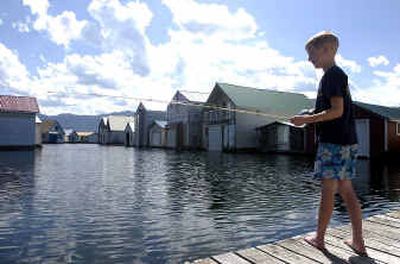Floating holiday

BAYVIEW, Idaho – Jess and Laura Brown’s lake getaway is small, stylish and surrounded by water.
Ten years ago, the California couple bought the first of two float homes on Lake Pend Oreille for about $44,000, acquiring waterfront living without the hefty price tag.
The compact float homes – each less than 800 square feet – come with a boat garage, living quarters, bedroom and bath. But the real draw, of course, is the water.
On a recent afternoon, the French doors in the Browns’ second float house opened out to the dock, where a small table was set for afternoon cocktails. Six hours after leaving their home for the Oakland Airport, the Browns can be out on the dock, watching sailboats and speckled trout slipping through the lake’s clear green waters.
“When we come up here,” said Jess Brown, “we never want to leave.”
Realtors are seeing a renewed interest in North Idaho’s float homes, a trend they credit to escalating cost of lakefront real estate.
Waterfront lots start around $300,000, a figure beyond most families’ budgets for recreational property. Float homes cost a fraction of that, though buying one is akin to purchasing a trailer in a mobile home park: You own the house, but pay a monthly moorage fee. In Bayview, where the majority of North Idaho’s 170 float homes are concentrated, moorage fees start around $175 per month.
“They’re affordable waterfront,” says Coldwell Banker Realtor Doug Landwehr. “We get inquiries from all over the United States.”
Within the last year, eight float homes sold through the Coeur d’Alene Multiple Listing Service. The average sales price was $70,000.
Four float homes are currently listed for sale, with asking prices ranging from $39,000 to $200,000. However, many change hands without a Realtor, through word-of-mouth advertising. The owners know somebody who knows somebody who wants one, Landwehr said.
“They’ve been one of the best-kept secrets,” said Lew Wilson, of Spokane, who is president of the Bayview-based Floating Homes Association of Idaho. The association’s 60-plus members hail from Missouri, Arizona and Canada, as well as the Inland Northwest.
The Browns were typical buyers. After visiting relatives in North Idaho, they wanted a lake place. “We thought that real estate prices would be relatively inexpensive here. They were higher than we expected,” Jess Brown recalled.
His wife’s cousin listened to the couple’s criteria for a vacation getaway. “What you need is a float home,” she suggested.
The Browns walked the docks in Bayview, searching for “For Sale” signs. In short order, they were owners of a 1934 float home, used primarily as a fishing cabin.
Many of North Idaho’s float homes date back to the 1930s and 1940s. The structures had humble beginnings as boat garages for lake fishermen. They also provided cheap housing for laborers who worked at lime quarries and kilns on the shores of Lake Pend Oreille. Later residents added water and electricity.
The state stopped issuing permits for new float homes in 1974, amid concerns about private structures in public waters, and waste disposal from float homes without sewer hookups. Float homes moored on the lakes before the moratorium took effect, were allowed to remain.
“You can’t build from scratch,” Landwehr said. “You have to buy an existing float home and remodel it.”
Jess Brown briefly wondered about resale value before the purchase. Banks are selective about financing float homes. As a result, most transactions are cash, or owner-contract.
However, “I felt that people have such of a love for them, that there would always be a market,” Jess Brown said. The couple hired a diver to inspect the cedar logs that provide the home’s flotation, and signed the papers.
The quaint, one-bedroom float house was an instant hit with family and friends. It attracted so much overnight company that the couple bought a second float home in 2002.
Now the Browns have living quarters and a guest house. Total cost for both purchases and extensive remodeling: less than $150,000.
The first float house retains a vintage feel, with low ceilings, knotty pine paneling and an antique fly fishing rod mounted on the wall. The second float house is airy and modern, with retro touches. Both obey the cardinal rule of float home decorating, which is “think light.”
“We knew the moment the neighbors installed their refrigerator, because their house leaned our way,” Laura Brown said. “This isn’t a good place for heavy furniture.”
Colorful paintings purchased during the couple’s travels in Africa give their second float home a sophisticated flair. The Browns kept the original Formica kitchen countertop, which Laura refers to as a “shocking pink,” and the brass hood above the stove. Glassware in ‘70s shades of green and amber fill the cabinets.
“This was going to be our guest house,” Jess Brown said. “But after we remodeled it, we liked it so much that we stayed here.”
The Browns visit the float homes frequently from May through October, when fog and gray skies set in. Lake life is the perfect counterpoint to the busy professional lives the couple leads as a farm lobbyist and water district manager in California, Laura Brown said.
Even with neighbors on either side, a sense of peace pervades the place.
“It’s a great place to entertain, because everybody loves it. People come here to relax,” she said. “There’s no cell phone reception, no cable and no Internet.”